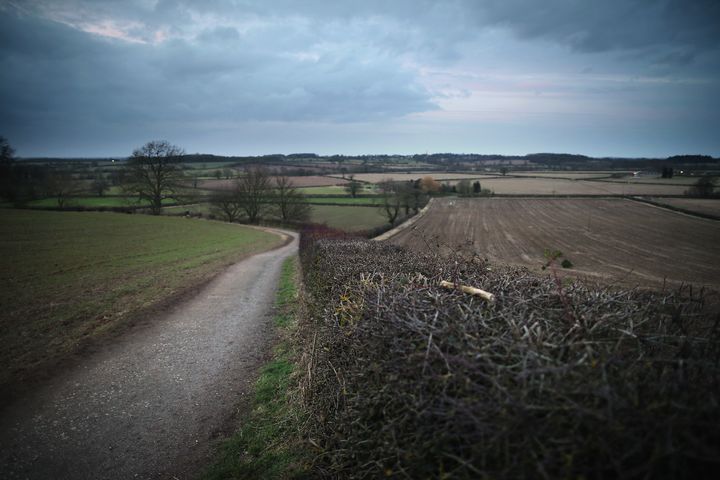
Bosworth battlefield is one of our most important heritage sites. It is where the last English king to be killed fighting in battle, Richard III, fell; it is where the Tudor dynasty under Henry VII was born. It is a battle that truly changed the course of history. It is a battlefield I have spent years researching, from climbing up rickety ladders to the top of a medieval church to view the original site of the fighting, to searching for original documentary evidence in the Vatican library to write my history of the battle and my biography of Richard III.
And it is a battlefield which has been remarkably preserved- until now. The battle was fought along a Roman road and in open fields, then a marshy area known as Redemore, which survive relatively unscathed. Yet a planning application to build an 83 acre sized driverless car testing track on an area of the battlefield threatens all this.
In 2010, I was present at the conference that unveiled the forgotten location of the battlefield site, demonstrating that the battlefield was far larger than previously thought, stretching across a wide area than just Ambion Hill where the Heritage Museum is based. Nearly forty cannon balls were found by an expert archaeological team led by Dr Glenn Foard - the largest number ever found on a medieval battlefield, as well as the famous silver boar- Richard III’s insignia- demonstrating that Richard’s men fought in a different location to where previously thought. Then Richard III was found under tarmac in a Leicester carpark, sparking a massive renewed interest in the last Plantagenet king and his grisly end, being trussed up naked like a hog over the back of a horse, his head literally sheathed open and a sword thrust through his brain. It shows that our history, when we look hard enough, can really be alive and kicking.
Now Richard III has been removed from beneath the tarmac, a new threat to tarmac over an important part of the battlefield site is a clear and present danger. A planning application to build a driverless car testing track across a large area of the battlefield will not only destroy the panoramic that has remained relatively unchanged for centuries- the same view that Henry Tudor would have had as he approached the battlefield tentatively with his (mainly French) troops. If the fields- that have still yet to be subjected to the painstaking archaeological process that adjoining fields have been, yielding potentially rich rewards- are levelled for good, then we risk losing valuable evidence that can enhance our knowledge of this pivotal battle forever.
Ultimately, this local planning application threatens to set a precedent which in turn could endanger other historic battlefields across the country.
Since 1995, 47 battlefields in England have been designated as registered battlefields by Historic England—previously called English Heritage. Under planning legislation, the effect on the site and setting of a registered battlefield should be a material consideration for any proposed development. Planning policy statement 5, “Planning for the Historic Environment”, states that there should be a presumption in favour of the conservation of designated historic assets, and that local authorities should assess whether the benefits of an application for development outweigh the disbenefits. It also recognises that many historic assets are not currently designated and that, despite that, there should be a presumption in favour of conservation such that substantial harm to, or loss of, the battlefield should be “wholly exceptional”.
Several issues with the legal status quo deserve to be reconsidered. Substantial harm to a battlefield location should be “wholly exceptional”, but what of “minor harm”? Notwithstanding that those definitions are entirely subjective, a series of planning applications granted over a period of time may individually be defined as causing only minor harm, but in combination may cause incremental damage that is defined as substantial harm. The culture of permissiveness in our planning process allows for historic sites to be substantially eroded without the law ever being broken. Over time, subjective decisions that encroach on an historic battlefield site create an objective reality of destruction. No one would suggest that to take a single stone from Stonehenge would be considered minor harm, for clearly that would not be the case. One stone of many, once taken, would permanently alter the appearance and the historic preservation of the site.
Perhaps one of the long-standing issues with getting battlefield preservation taken seriously is that so much of it is not visible to the naked eye. The dead, their remains and their relics are buried, so we are faced with what is unknown rather than what is known. If we knew what was there hidden beneath the fields, we would preserve it; yet not knowing currently allows for battlefields to be thrown into the mix of the planning process. To argue that just 1% of a battlefield might be affected by a development is entirely to miss the point. That could be the 1% of a battlefield that witnessed the most important stages of combat or may yield archaeological treasures of national importance, just as the discovery of the Bosworth boar demonstrated.
Last week in Westminster, I argued that there was a case for thinking again about how we preserve ‘Areas of National Historic Interest’ just as we do Areas of Outstanding Natural Beauty. But for now, the so-called ‘second Battle of Bosworth’ has yet to be won- with a decision due in a matter of days. Already over 12,700 people have signed a petition against the planning application, which will be decided by Hinckley and Bosworth Borough Council on 25 September. Objections have come far and wide, from Historic England to the Battlefields Trust, the Richard III Society- and indeed the Henry Tudor Society. With the planning application due to be debated and decided in a matter of days, objections can officially still be lodged by emailing planning@hinckley-bosworth.gov.uk quoting the planning reference 18/00425/FUL.
This is not some kind of historical nimbyism, eschewing the advance of technology for the sake of the past. It has been modern technology that has shown that there is precious more to be discovered on many of our battlefield sites, transforming our understanding of battles- and the course of history that they altered.
Not only should we still be respectful of a site where a thousand men perished: the relics and treasures of the dead are still to reveal themselves. To build over one part of a battlefield site, threatens to set a precedent of permissiveness that could erode our ability to protect our battlefields across the country. We should plant our standard squarely on preserving Bosworth and its heritage, both past and yet to be discovered.
Chris Skidmore MP is author of Richard III: Brother, Protector, King (2017) and Bosworth: The Birth of the Tudors (2013)
